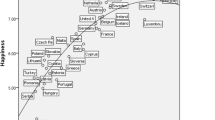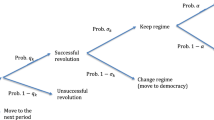Abstract
Several disciplines in social sciences have shown that institutions that promote cooperation facilitate mutually beneficial exchanges and generate prosperity. Drawing on these insights, this paper develops a Reservation Economic Freedom Index that classifies institutions on a sample of Indian reservations concerning whether these intuitions will enhance the prosperity of Indians residing on these reservations. The development of this index is guided by the research of political scientists, economists, other social science disciplines, and research in law. When correlating this index with Indian incomes, the evidence shows a statistically significant positive correlation between reservations with prosperity-enhancing institutions and their economic prosperity.

Similar content being viewed by others
Notes
In 1995 and 1996, the two first quantitative measures of economic freedom were published. The first was the Index of Economic Freedom produced by the Heritage Foundation that provides a ranking of countries based on their level of economic freedom. The second index, titled the Economic Freedom of the World index, was produced by the Fraser Institute. That index also provides historical data on economic freedom from 1975 to 1995. Both indices focus on the rule of law, the size of government, the regulatory environment and openness to trade. The Fraser Institute’s index also includes the soundness of money.
Following their inception, scholars used these indices to test hypotheses regarding the effect of economic freedom on outcomes such as national economic growth, measures of national health, income inequality, etc. The findings from that research provide strong support for the hypothesis that economic freedom improves a variety of economic and non-economic outcomes. Simply comparing the nations in the top quartile (ranked by economic freedom using the Fraser Institute’s index) to those in the bottom quartile in 2017 shows some stark differences in national outcomes. Those in the top quartile of the 2017 Economic Freedom of the World index had an average GDP per capita of $36,770, while those in the bottom quartile were $6,140. In top quartile nations, only 1.8% of the population lives in extreme poverty. In bottom quartile, 27.2% of the population lives in extreme poverty (Gwartney et al., 2019).
The Wealth Of Nations, Book II, Chapter II, p.329, para. 106.
Tribal code tables of contents are usually well organized and have descriptive titles that allow you to see what topics the code covers. See, for example, http://www.winnebagotribe.com/images/joomlart/corporate/tribe/court/tribalcode/2017-WTN-TRIBAL-CODE.PDF.
Some areas have different names in different codes but are relatively uniform in terms of focus.
Cooter and Fikentscher (2008) write “[a]cess to past cases is easiest in the larger tribes where the courts have more resources and keep better records.‘-Some large tribes build common law on precedents, as in English common law. Many smaller tribes rely on loosely structured case-by-case practice. In all jurisdictions, the statutes enacted by the tribal council are more accessible and more recited than case law decided by judges.”
See: https://www.bia.gov/sites/bia.gov/files/assets/as-ia/ieed/ieed/pdf/idc1-024558.pdf for more details.
Anderson and Parker (2022) document that pre-contact, Indians did abide by the rule of law and built healthy economies based on clear property rights.
Dippel at al. (2022) describe how the allotment process was influenced by the discretion exercised by local “Indian Agents” appointed by the Bureau of Indian Affairs.
Although some tribes in Minnesota, Oregon and Wisconsin were exempted due to having sufficient judicial systems in place (Anderson and Parker 2008).
For a historical perspective of criminal justice institutions see Crepelle et al. (2022b)
Crepelle at al. (2022a) describe the effect of per capita payments, derived from casinos, on governance.
While included in the index, the Saint Regis Mohawk Reservation, NY, and the Agua Caliente Indian Reservation and Off-Reservation Trust Land are not included in the analysis relating the index to median household American Indian income, as the ASC did have this data series for these two reservations. Thus, the analysis is based on 87 reservations.
In Ute Treaty of 1868, the government offered to create reservations for six Ute tribes across the region and provide annuities of food and other supplies. For reasons such as the requirement of sending Ute children to white schools and the difficulty in establishing and operating Indian Agencies collapsed the treaty. The Dawes Act of 1877, also called the General Allotment Act, divided Indian reservations across the US into small plots for allotments. However, Dawes Act didn’t apply to the Utes, because white Coloradans preferred that Utes left altogether, until the Hunter Act of 1895. This act applied the Dawes Act to the Utes in CO but also gave the tribes the option to reject allotments.
The water and irrigation problem would only be solved later in 1986 with the Colorado Ute Indian Water Rights Settlement Agreement.
DOI shares on its website that the “Act allowed for Indian tribes to have greater autonomy and to have the opportunity to assume the responsibility for programs and services administered to them on behalf of the Secretary of the Interior through contractual agreements.” See more at https://www.bia.gov/regional-offices/great-plains/self-determination.
Indian Mineral Development Act of 1982 authorized tribes to negotiate with energy companies themselves.
https://www.rwpc.us/about-us/areas-of-operations/ Accessed February 5, 2023.
See Southwest Colorado’s Comprehensive Economic Development Strategy 2021 at https://www.region9edd.org/uploads/CEDS_Update_2021%20-%20Copy%202.pdf.
View Southern Ute Tribal Code at http://www.narf.org/nill/codes/southernute/.
References
Acemoglu, D., & Robinson, J. A. (2008). The persistence and change of institutions in the Americas. Southern Economic Journal, 75(2), 282–299.
Anderson, R., & Warren (2016). Native american reservation constitutions. Constitutional Political Economy, 27(4), 377–398.
Anderson, T. L., Dominic, P., & Parker (2008). Sovereignty, credible commitments, and economic prosperity on american indian reservations. The Journal of Law and Economics, 51.4, 641–666.
Anderson, T. L., Dominic, P., & Parker (2022). Culture, sovereignty, and the rule of law: Lessons from indian country. Public Choice. https://doi.org/10.1007/s11127-022-01026-9.
Arrow, K. J. (1969). “The Organization of Economic Activity: Issues Pertinent to the Choice of Market Versus Non-Market Allocation,“ in The Analysis and Evaluation of Public Expenditures: The PPB System, Vol. 1, pp. 59–73. U.S. Joint Economic Committee, 91st Congress, 1st Session. Washington, D.C.: U.S. Government Printing Office.
Boettke, P. J., Coyne, C. J., & Peter, T. L. (2008). Institutional stickiness and the New Development Economics. The American Journal of Economics and Sociology, 67(2), 331–358.
Buchanan, J. M. (1962). and Gordon Tullock The Calculus of Consent: Logical Foundations of Constitutional Democracy. Chapter 5, http://www.econlib.org/library/Buchanan/buchCv3.html.
Cooter, R. D., & Wolfgang Fikentscher (2008). American Indian Law Codes: Pragmatic law and tribal identity. The American Journal of Comparative Law, 56.1, 29–74.
Cornell, S. E. (2006). and Joseph P. Kalt. “Two approaches to economic development on American Indian reservations: one works, the other doesn’t.” Cambridge, MA: Harvard Project on American Indian Economic Development.
Cornell, S., & Kalt, J. P. (2000). Where’s the glue? Institutional and cultural foundations of american indian economic development. The Journal of Socio-Economics, 29.5, 443–470.
Crepelle, A., & Fegley, T., and Ilia Murtazashvili (2022b). Military societies: Self-governance and criminal justice. Indian country " Public Choice. https://doi.org/10.1007/s11127-022-01004-1.
Crepelle, A., & Mahdavi, P., and Dominic Parker (2022a). Effects of per capita payments on governance: Evidence from tribal casinos. Public Choice. https://doi.org/10.1007/s11127-022-01012-1.
Dippel, C., Frye, D., & Leonard, B. (2022). “Bureaucratic discretion in policy implementation: evidence from the Allotment Era.“ Public Choice. https://doi.org/10.1007/s11127-022-01019-8.
Friedman, M. (1962). Capitalism and freedom. Chicago, IL: University of Chicago Press.
Gwartney, J., Lawson, R., Hall, J., & Murphy, R. (2019). Economic Freedom of the World: 2019 Annual Report. Vancouver, BC: Fraser Institute.
Hayek, F. (1944). The road to serfdom. Chicago, IL: University of Chicago Press.
Mises, L., & Von. (1952). Planning for Freedom. Libertarian Press.
North, D. C. (1995). Five propositions about institutional change. Explaining social institutions, 99, 116–131.
North, D. C. (1991). “Institutions,” Journal of Economic Perspectives, 5(1): 97:112.
Philp, K. R. (1977). John Collier’s crusade for indian Reform, 1920–1954. Tucson: University of Arizona Press.
Quintana, F., & Leon (2004). Ordeal of change: The southern Utes and their neighbors. Rowman Altamira.
Regan, S. E., & Terry, L. (2014). Anderson. “The energy wealth of indian nations. LSU J Energy L & Resources, 3, 195.
Rodrik, D. (2004). “Growth Strategies.” Handbook of Economic Growth.
Royster, J. V., “Practical, & Sovereignty (2008). Political Sovereignty, and the indian Tribal Energy Development and self-determination act. Lewis & Clark L Rev, 12, 1065.
Shipps, T. H. (2007). Tribal energy resource agreements: A step toward self-determination. Natural Resources & Environment, 22(1), 55–57.
Simmons, V. M. C. (2001). The Ute Indians of Utah, Colorado, and New Mexico. University Press of Colorado.
Smith, A. “An Inquiry into the Nature and Causes of the Wealth of Nations” (1776): 458.
South Dakota Legislature (2015). “Tribal Economic Development task force final report” URL: https://sdlegislature.gov/docs/referencematerials/requiredreports/RR0107201621.pdf.
Thompson, J. (2010). “The Ute Paradox.” URL: https://www.hcn.org/issues/42.12/the-ute-paradox.
Williamson, C. R. (2009). Informal institutions rule: Institutional arrangements and economic performance. Public Choice, 139, 371–387.
Young, R. K. (1997). The Ute Indians of Colorado in the twentieth century. University of Oklahoma Press.
Acknowledgements
I thank Ashruta Acharya and Joaquin Henault for their excellent research assistance. An early version of this article is co-authored with Kyle Musser.
Author information
Authors and Affiliations
Corresponding author
Additional information
Publisher’s Note
Springer Nature remains neutral with regard to jurisdictional claims in published maps and institutional affiliations.
Rights and permissions
Springer Nature or its licensor (e.g. a society or other partner) holds exclusive rights to this article under a publishing agreement with the author(s) or other rightsholder(s); author self-archiving of the accepted manuscript version of this article is solely governed by the terms of such publishing agreement and applicable law.
About this article
Cite this article
Stratmann, T. A reservation economic freedom index. Public Choice (2023). https://doi.org/10.1007/s11127-023-01088-3
Received:
Accepted:
Published:
DOI: https://doi.org/10.1007/s11127-023-01088-3




